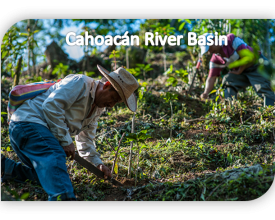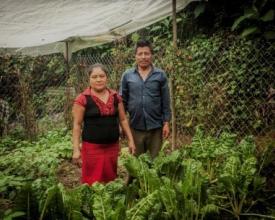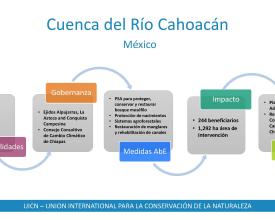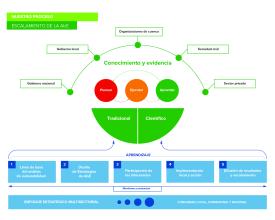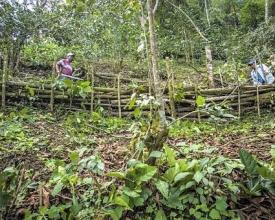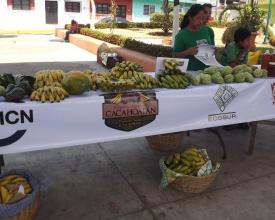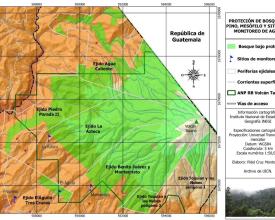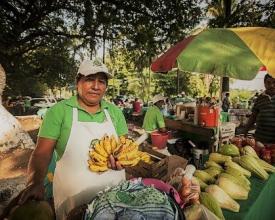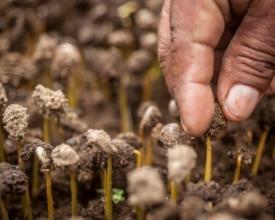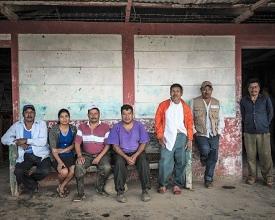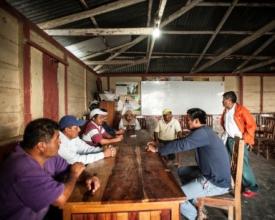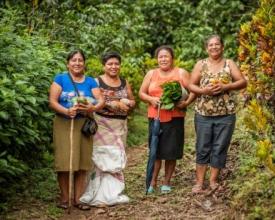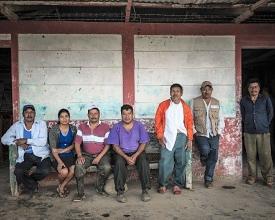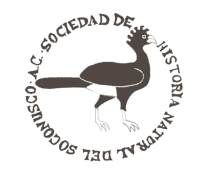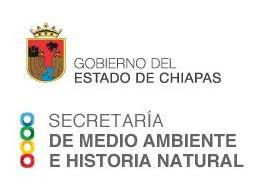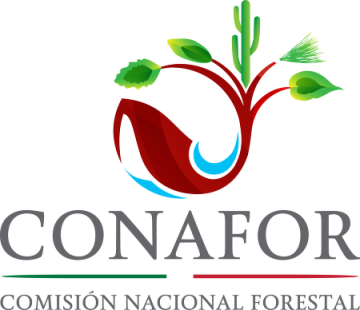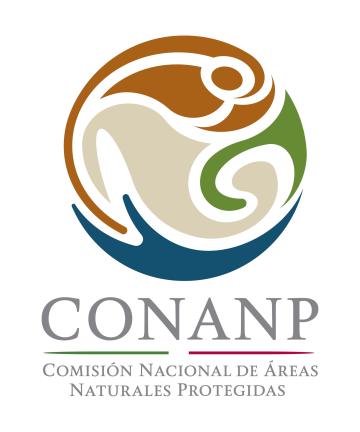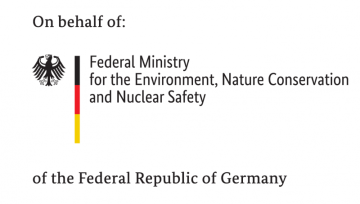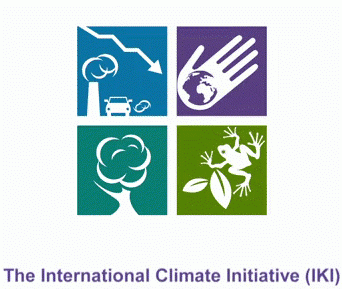
Food and water security in ejidos around the Tacaná Volcano, Mexico
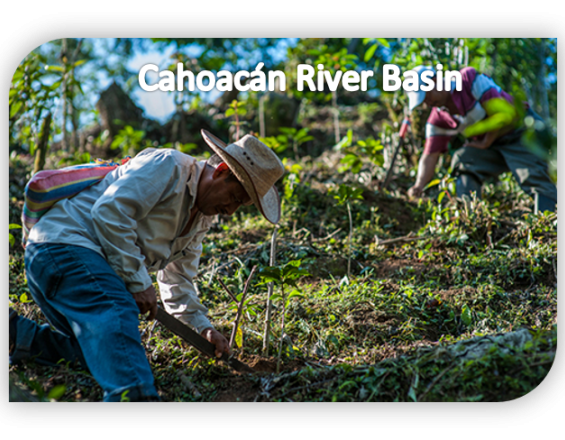
To reduce the vulnerability to climate change of communities in the surrounding landscape of the Tacaná Volcano Biosphere Reserve, EbA measures were implemented with two communities: La Azteca and Alpujarras. Communities are organized as ejidos, which is a land-tenure structure in Mexico.
The solution aimed to improve resilience of both the cloud forest and the agroforestry coffee production in order to face storms and heavy rains causing erosion, landslides and causing loss of lives, impacts to water springs, and agricultural production.
This combination of measures would improve water capture, reduce water erosion, and additional food products will be obtained for family consumption and comertialization. Actions were taken through state, federal and project funds to ensure sustainability in the medium term.
Context
Challenges addressed
- The area is subject to storms, strong winds, more frequent droughts and heat waves, floods and changes in rainfall patterns. This reduces the availability and quality of water and favours the incidence of pests, producing crop losses (mostly coffee and corn). In the future, more storms, hurricanes, plagues and landslides are expected.
- Water erosion is a problem that impacts many downstream communities. If mesophilic forests are replaced by temporary agriculture in the upper basin, soil loss could increase up to 240%.
- > 60% of cloud forest tree species are in some category of threat.
- Sustainable development in the upper basin faces challenges, such as limited road access, heavy dependence on agriculture (especially coffee) and contamination of water bodies due to poor waste management.
- Ejido community members need more capacities and knowledge regarding EbA options as well as opportunities to elevate their adaptation needs before government entities.
Location
Process
Summary of the process
The solution in ejidos of the Cahoacán and Coatán basins, Chiapas, is presented in 3 Building Blocks (BB) that combine field actions, monitoring, exchange of experiences, participation, planning and the valuing of ecosystem services.
The implementation of EbA measures (BB2) is combined with the strengthening of governance for adaptation (BB3) under a "learning by doing" approach (BB1).
Promoting access by the ejidos to Payments for Environmental Services helps to encourage the application of EbA measures (reforestation, surveillance, soil conservation and productive diversification) in degraded forests of hydrological priority. Different practices are tested to increase the resilience of ecosystems and food security, which can be monitored and evaluated over time.
At the community level, a process of collective learning and empowerment is generated that includes the acquisition of knowledge on vulnerability, EbA, food and water security (BB1 and 2) and legal and policy frameworks relevant to climate change (BB3). Thus, progress is made in the governance of the ejidos and their capacity for political advocacy and accessing financial resources, which ultimately strengthens their capacity for climate change adaptation.
Building Blocks
Increasing environmental and social resilience based on forest cover and water
After analysing vulnerabilities and adaptation establishing priorities, the ejido La Azteca and ejido Alpujarras sought to protect the ecosystem services provided by their forests (water capture, biodiversity, soil and fertility structure) aiming to benefit their livelohoods and resilience to climate change.
The following EbA measures and actions were implemented to face heavy rains, storms, erosion and to improve ecosystem resilience, soil water retention and water downstream.
1. Protection and restoration of the cloud forest in the Tacaná Volcano Reserve. Specific actions were:
- natural regeneration of forest degraded areas
-
reforestation with native species
-
wildfire preventative measures such as firebreaks
- soil conservation practices
- surveillance to prevent illegal logging, illegal hunting and extraction of flora and fauna, forest fires, and to detect outbreaks of pests
2. Optimization of agroforestry systems,:
- Soil conservation practices (e.g. live fences, terraces and breakwater small natural constructions). Live fences use plant species to divide plots, provide shade and protect againts erosion.
- introducing forest and fruit species into coffee plantations (shade-grown).
Measures helped to improve and maintain the resilience and integrity of the natural forest.
Enabling factors
- Ejido assemblies, which are important (decision-making) entities of the communities of Chiapas, are key for the implementation, and long-term monitoring and evaluation of EbA measures for climate change adaptation. The Ejido is a land tenure structure in Chiapas, Mexico.
- The existance of the Payment for Environmental Services scheme which has been operating in Chiapas since 2012, was key to support actions and enable funds for the sustainable management of mountain mesophilic forest and agroforestry systems (~4000 ha).
Lesson learned
The main goal of the solution was to improve the resilience of communities and ecosystems towards climate-related impacts. This was achieved by implementing EbA measures in combination with synergizing measures of community-based adaptation, certain CO2 mitigation strategies (such as Payment of Ecosystem Services for the protection of the forest), and the integrated water management of the Cahoacán river basin (were communities are located).
One important lesson is that EbA measures cannot be isolated, but need to be taken at a basin or microbasin scale to impact on water related ecosystem services.
"Action learning" and monitoring to increase capacities and knowledge
An "action learning" approach consisted of training and supporting communities to implement EbA measures.
- A socio-environmental vulnerability assessment of 2 ejidos (211 families) was carried out in a participatory manner to identify and prioritize EbA measures.
- Technical support is provided complementing families' traditional knowledge, to ensure that EbA measures contribute to food and water security.
- Exchanges and trainings are organized for producers, ejido authorities and municipalities on climate change, food security, sustainable forest management and soil conservation.
Furthermore, the solution focused on generating evidence on the benefits of EbA measures on water and food security:
- In collaboration with IUCN and the International Center for Tropical Agriculture (CIAT) household surveys were carried out to study the benefits of the EbA measures or food security. The joint methodology was also applied in five other countries.
- A methodology to understand the effectiveness of EbA on water security was developed and was applied in La Azteca and Alpujarras. The methods include: interviews, focus groups and environmental data collection in the field (e.g. water quality).
Enabling factors
- CONAFOR implements the Forests and Climate Change Project in the area since 2012, aimed at reducing the climatic vulnerability of several ejidos through the protection and sustainable use of ejido forests. Due to its complementarity, this project creates enabling conditions for the adoption of EbA measures.
- For years, IUCN and its partners have advocated for the protection and sustainable use of forests in the Tacaná Volcano basins. Having previously worked with the La Azteca ejido under the Cahoacán Project, they know the local reality well.
Lesson learned
- Maintaining technical support in the area for almost 15 years (since 2004) achieves continuous and joint learning among technical advisors, ejido members and institutions. In this way, problems can be internalized and the vulnerabilities that are identified are resolved as a team. Relying on the "learning by doing" approach fosters processes that are iterative and mutually supportive, and ultimately are conducive to broad, lasting and adaptive learning.
Strengthening governance for adaptation
Within Chiapas rural governance structures, the ejido Assembly is the main social platform where participatory decisions are made regarding natural resources. Ejido land tenure in Mexico is an example of individual and communal tenure co-existing within communities. Communal lands are titled in the name of the community leaders. Ejido Azteca and Alpujaras are partly witin the Tacana Volcano Reserve.
With a view to increasing the ejidos adaptive and management capacity main actions undertaken under this solution were:
- Training on climate change legal and policy frameworks was delivered to ejido leaders and municipalities officers.
- Development of the Local Strategy for Sustainable Development under Climate Change of La Azteca ejido.
- Conformation of ejido's Water Committees.
- Public presentations on events such as the VII National Congress on Climate Change Research. Leaders shared the benefit of soil conservation practices and forest protection to water security.
Enabling factors
- The communities living within the river basin -organized through the ejido assemblies- are strong advocates for the sustainable use of resources/conservation for improving water and food security and ecosystem-based adapation.
- Technical knowledge and leadership skills are important to inspire the rest of the community and ensure decision making for communal lands in the Assembly with a view of building up resilience.
Lesson learned
- With the ejido Assembly making decisions regarding the use of common goods and ecosystem services, governance for adaptation is strengthened. However, there still lacks further organization of the ejido’s social capital and articulation with other organizations, civil associations and the municipality, in order to convert the problems faced by the owners and possessors of forest lands into opportunities.
- Governance must continue to be strengthened in order to give sustainability to EbA actions, so that their continuity is not dependent on external assistance.
Resources
Impacts
- Greater knowledge of ejido leaders on EbA and sustainable forest management.
- EbA measures that favour water and food security implemented with 211 families from the La Azteca and Alpujarras ejidos, mainly:
- soil conservation
- reforestation with native species in areas of common use (1012 ha of degraded mesophyll forests and areas with water sources in La Azteca).
- agroforestry systems (276 ha) in productive plots of Alpujarras.
- Synergies with other efforts (eg. IUCN’s Cahoacán Project and CONAFOR’s restoration program) in particular to promote access to Payments for Environmental Services (1288 ha).
- Collaboration between the ejidos La Azteca and Agua Caliente for the joint reforestation of 294 ha of degraded forests.
- Initial research on the benefits of EbA for food security using a Monitoring and Evaluation methodology with 20 families (10 from each ejido).
- Strengthening of ejido Assemblies as a participatory social platform for the protection of forests.
- Participatory preparation of a Local Strategy for Sustainable Development under Climate Change in the La Azteca ejido.
- EbA priorities and vulnerability studies of the La Azteca and Alpujarras ejidos presented at the state level.
Beneficiaries
- 211 families from the ejidos La Azteca (91) and Alpujarras (120)
- Municipality of Cacahoatán
- Downstream communities affected by the effects of deforestation in the upper basin (less water, greater risk of disasters and sedimentation on the coast).
Sustainable Development Goals
Story
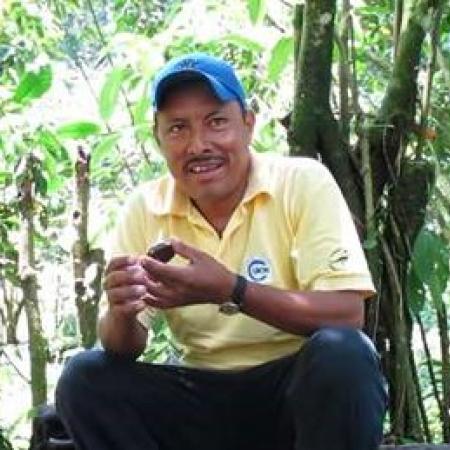
The ejidos La Azteca (91 families) and Alpujarras (120 families) are located in the upper basin of the Coatán River and the middle basin of the Cahoacán River, respectively, within the Tacaná Volcano Biosphere Reserve. In the area mainly coffee is grown, but also corn, beans and wheat for subsistence. Although there, cattle raising is of low intensity, it is widely practiced extensively and open grazing in the highest parts of the volcano has been practiced for decades without regulation. Added to this threat, there are also forest fires and extreme weather events such as hurricane Stan, which hit the region in 2005 and was highly damaging, causing crop and animal losses and damages to homes.
According to the Reserve Management Program (2014), measures are required to restore forests, conserve water and soils, stop the advancement of the agricultural frontier and raise resiliency or the natural response capacity to extreme events expected to increase in frequency and magnitude in the future. Through the protection of ecosystems and work with producers in agroforestry systems and best agricultural practices, promoted through a system of Payment for Environmental Services, this solution serves precisely these needs in two basins associated with the Tacaná Volcano.
Mr. Antonio Hernández Salas, member of the ejido La Azteca (Chiapas, Mexico): "We are caring for our forests so that, in this area, water recharge does not decrease. We know that with this vital liquid we can do many things and that is why we are alive and thriving, because we maintain our waters.
We have changed coffee varieties from Bourbons or Arab to "catimor" or "caturra" that are smaller and more resistant; we have exchanged experiences in Guatemala and in Oaxaca to understand how to mitigate climate change impacts.
That is why we are working shoulder to shoulder for the conservation of our environment, our natural resources and our forests. We have 1500 ha of land that are regenerating water, the waters have dried up in March-April in other communities because they do not have good management and care for the environment, but in our community of La Azteca we have never suffered from this situation.
I am infinitely grateful that we always exchange ideas, make questions, expand information, I always learn more and that I take with me to strengthen my community more."
